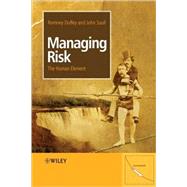
What is included with this book?
Romney B. Duffey, Principal Scientist, Research and Product Development, Chalk River, Atomic Energy of Canada Ltd.
Romney B. Duffey is a leading expert in commercial nuclear reactors and is active in global environmental and energy studies and in advanced system design. He is currently Principal Scientist for AECL (Canada), having previously held a number of leadership roles within the US utility industry and in government laboratories and programs. He is a past chair of the American Society of Engineers' Nuclear Engineering Division, and the American Nuclear Society's Thermal Hydraulics Division. He has authored over 200 papers and articles.
John W. Saull, Executive Director, International Federation of Airworthiness, UK.
John W. Saull is an internationally renowned aeronautical engineer with over 45 years' experience in commercial aircraft certification, manufacturing, maintenance, personnel licensing and flight operations, and is a leading expert in safety management and human error. He is currently Executive Director of the International Federation of Airworthiness, having retired from his position as Chief Surveyor and Head of Operating Standards at the Civil Aviation Authority in 1996. He is currently a member of a number of international safety committees dealing with maintenance and human factors, and continues to be involved in organizing air safety conferences and chairing technical sessions.
| Contents | |
| About the Authors | |
| Preface | |
| Acknowledgements | |
| Definitions of Risk and Risk Management | |
| Introduction: The Art of Prediction and the Creation of Order | |
| Risk and Risk Management | |
| Defining Risk Managing Risk: Our Purpose, Plan and Goals | |
| Recent Tragic Outcomes | |
| Power Blackouts, Space Shuttle Losses, Concorde Crashes, Chernobyl, Three Mile Island and More | |
| How Events and Disasters Evolve in a Phased Development: The Human Element Our Values at Risk | |
| The Probable Improvement | |
| Probably or Improbably Not | |
| How this Book is Organised | |
| References | |
| Technical | |
| Summary | |
| Defining the Past Probability | |
| Predicting Future Risk: Sampling from the Jar of Life | |
| A Possible Future | |
| Defining the Posterior Probability | |
| The Engineers Have an Answer: Reliability | |
| Drawing from the Jar of Life: The Hazard Function and Species Extinction | |
| Experiencing Failure: Engineering and Human Risk and Reliability Experience Space Managing Safely: Creating Order out of Disorder Using Safety Management Systems | |
| Describing the Indescribable: Top-Down and Bottom-Up | |
| What an Observer will Observe and the Depth of our Experience | |
| References | p. 1 |
| The Universal Learning Curve | |
| Predicting Tragedies, Accidents and Failures: Using the Learning Hypothesis | |
| The Learning Hypothesis | |
| The Market Place of Life Learning in HTSs: The Way a Human Learns Evidence of Risk Reduction by Learning Evidence of Learning from Experience | |
| Case Studies Evidence of Learning in Economics Evidence of Learning in Engineering and Architecture | |
| The Costs of MistakesLearning in Technology: the Economics of Reducing Costs Evidence of Learning Skill and Risk Reduction in the Medical Profession | |
| Practice Makes Almost PerfectLearning in HTSs | |
| The Recent Data Still Agrees | |
| The Equations That Describe the Learning CurveZero Defects and Reality Predicting Failures | |
| The Human Bathtub Experience Space | |
| The Statistics of Managing Safety and of Observing Accidents Predicting the Future Based on Past Experience | |
| The Prior Ignorance Future Events: the Way Forward Using Learning Probabilities | |
| The Wisdom of Experience and Inevitability | |
| The Last, First or Rare Event Conclusions and Observations | |
| Predicting Accidents | |
| References | p. 2 |
| The Four Echoes Power Blackouts, Space Shuttle Losses, Concorde Crashes, and the Chernobyl and Three Mile Island Accidents | |
| The Combination of EventsThe Problem Is the Human Element | |
| The Four Echoes Share the Same Four Phases | |
| The First Echo: Blackout of the Power Grid Management's Role | |
| The First Echo: Findings Error State Elimination | |
| The Second Echo: Columbia/Challenger | |
| The Results of the Inquiry: Prior Knowledge | |
| The Second Echo: The Four Phases Management's Responsibility Error State Elimination | |
| The Third Echo: Concorde Tires and SUVs Tire Failures: the Prior Knowledge | |
| The Third Echo: The Four Phases Management's Responsibility Error State Elimination | |
| The Fourth Echo: Chernobyl | |
| The Chernobyl Accident: An Echo of Three Mile Island | |
| The Consequences Echoes of Three Mile Island | |
| The CausesError State Elimination | |
| The Fourth Echo: The Four Phases | |
| Regulatory Envir" | |
| Table of Contents provided by Publisher. All Rights Reserved. |
The New copy of this book will include any supplemental materials advertised. Please check the title of the book to determine if it should include any access cards, study guides, lab manuals, CDs, etc.
The Used, Rental and eBook copies of this book are not guaranteed to include any supplemental materials. Typically, only the book itself is included. This is true even if the title states it includes any access cards, study guides, lab manuals, CDs, etc.